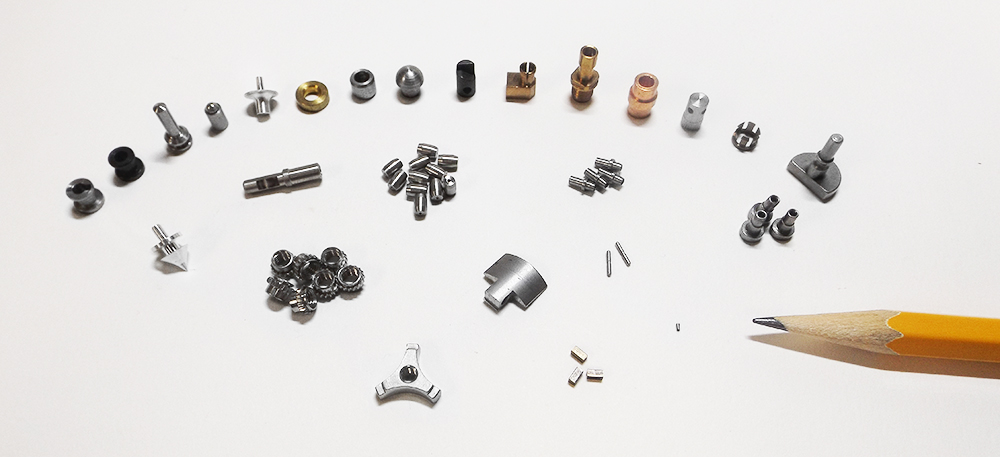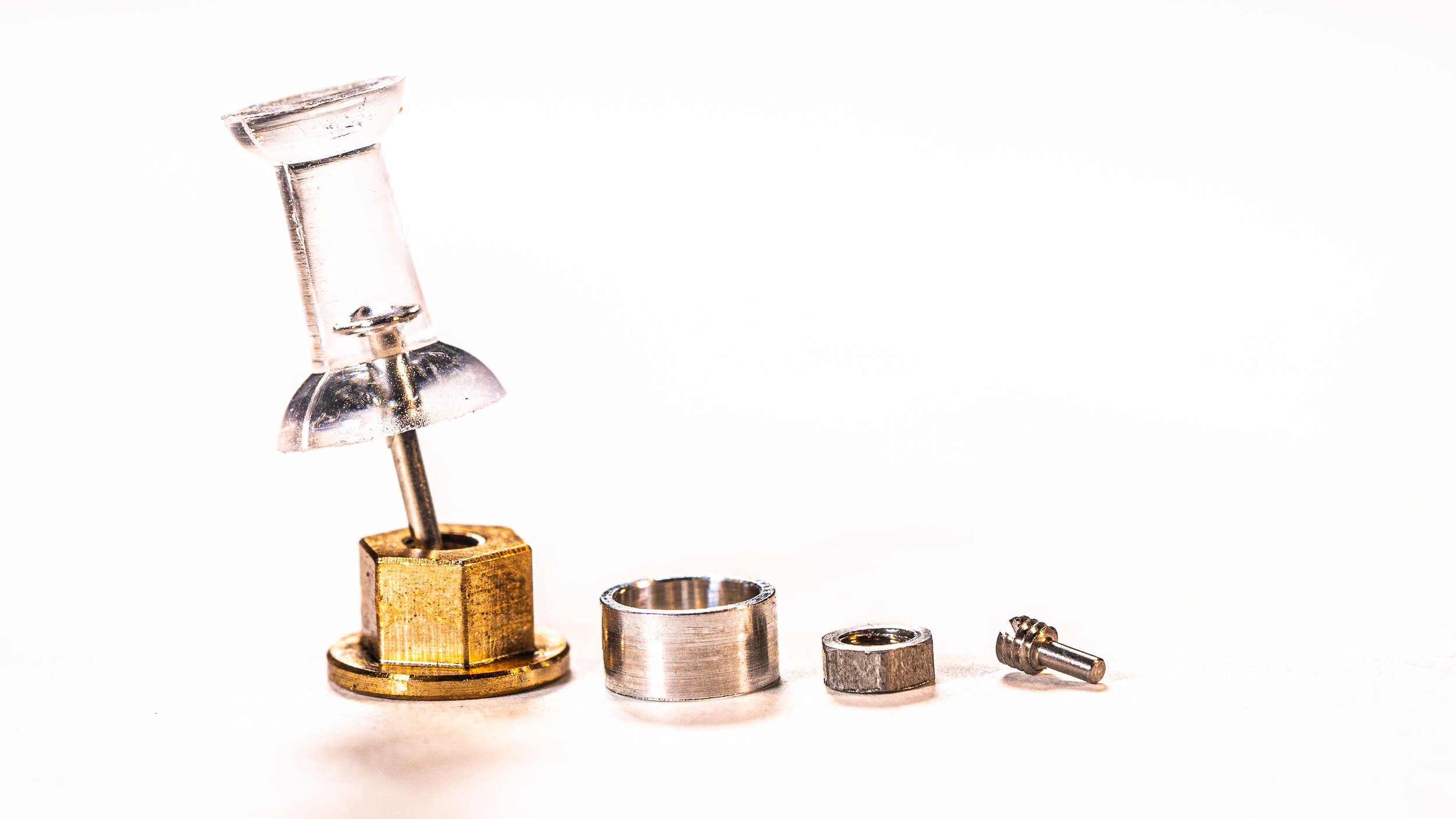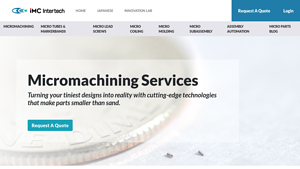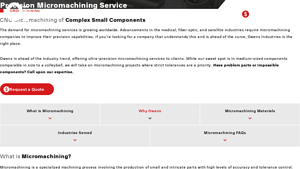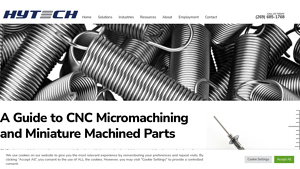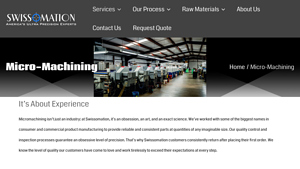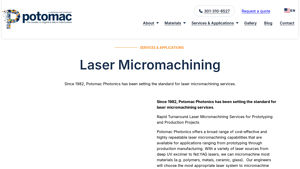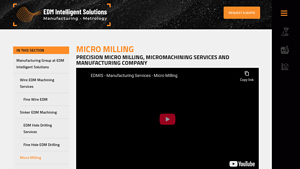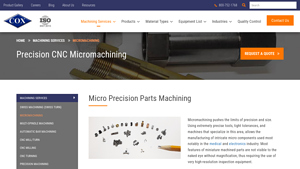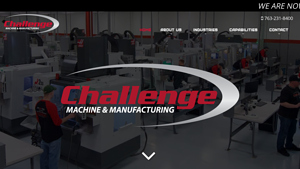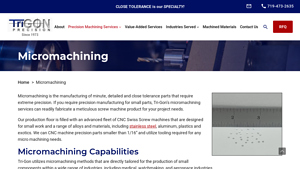Micromachining Services Guide: Type, Cost, Top List…
Introduction: Navigating the Global Market for micromachining services
In an era where precision and innovation define competitive advantage, sourcing micromachining services can pose significant challenges for international B2B buyers. As industries increasingly demand miniaturized components that adhere to stringent tolerances, navigating the complexities of global suppliers becomes crucial. This guide offers a comprehensive overview of micromachining services, covering essential topics such as types of processes (including micro milling, turning, and laser micromachining), diverse applications across sectors like medical devices and aerospace, supplier vetting criteria, and cost considerations.
By empowering B2B buyers from regions such as Africa, South America, the Middle East, and Europe—including rapidly evolving markets like Vietnam and Saudi Arabia—this guide provides actionable insights to streamline the sourcing process. Buyers will learn how to assess supplier capabilities, ensuring they select partners that not only meet technical specifications but also align with regulatory compliance and quality standards.
Whether you are exploring advanced manufacturing solutions or seeking to enhance product development timelines, this guide serves as your essential resource for making informed purchasing decisions in the dynamic landscape of micromachining services. Gain the knowledge necessary to navigate this critical sector, and position your business for success in a global marketplace where precision is paramount.
Understanding micromachining services Types and Variations
| Type Name | Key Distinguishing Features | Primary B2B Applications | Brief Pros & Cons for Buyers |
|---|---|---|---|
| Micro Milling & Turning | Utilizes CNC technology for precision machining of small components | Medical devices, aerospace parts | Pros: High precision, versatile materials. Cons: Higher costs for low-volume production. |
| Micro EDM | Employs electrical discharge for intricate shapes on conductive materials | Aerospace, electronics, medical devices | Pros: Excellent for complex geometries. Cons: Slower process compared to traditional machining. |
| Laser Micromachining | Uses ultra-fast laser beams for high-resolution features | Optics, microelectronics, sensors | Pros: Exceptional detail and precision. Cons: Limited material compatibility. |
| Micro Assembly | Focuses on assembling micro components with precision | Electronics, medical device manufacturing | Pros: Reduces assembly time and costs. Cons: Requires specialized handling and tooling. |
| Micro Injection Molding | Produces small parts through injection molding techniques | Consumer goods, automotive components | Pros: Cost-effective for high-volume production. Cons: Initial tooling costs can be high. |
What Are the Characteristics of Micro Milling & Turning Services?
Micro milling and turning are foundational techniques in micromachining, utilizing advanced CNC technology to create intricate components with high precision. This method is particularly suitable for industries like medical devices and aerospace, where tolerances are critical. B2B buyers should consider the complexity of their designs and the volume of production, as these factors influence the cost-effectiveness of using micro milling and turning services.
How Does Micro EDM Stand Out in Micromachining?
Micro EDM (Electrical Discharge Machining) is renowned for its ability to craft intricate shapes and features on conductive materials. This process is ideal for applications in aerospace and electronics, where precision and detail are paramount. Buyers should weigh the advantages of micro EDM’s capability to handle complex geometries against its slower processing speed compared to traditional methods, especially for high-volume needs.
Why Choose Laser Micromachining for Precision Needs?
Laser micromachining employs ultra-fast laser beams to achieve exceptional resolution in micro components, making it a go-to for optics and microelectronics. Its ability to produce highly detailed features is unmatched, but buyers must consider the limitations in material compatibility. This technique is most advantageous for projects that prioritize detail over volume.
What Are the Benefits of Micro Assembly Services?
Micro assembly services leverage expertise in the precision assembly of small components, making them essential for industries like electronics and medical device manufacturing. This service significantly reduces assembly time and costs but requires specialized handling and tooling. B2B buyers should evaluate their assembly needs and the potential for integration into existing production lines to maximize benefits.
How Does Micro Injection Molding Fit into Micromachining?
Micro injection molding is a technique designed for producing small parts with high efficiency. It is especially prevalent in consumer goods and automotive components, where high-volume production is essential. While this method offers cost-effectiveness for large runs, buyers must be mindful of the initial tooling costs, which can be significant. Understanding the trade-offs between upfront investment and long-term savings is crucial when considering this option.
Key Industrial Applications of micromachining services
| Industry/Sector | Specific Application of micromachining services | Value/Benefit for the Business | Key Sourcing Considerations for this Application |
|---|---|---|---|
| Medical Devices | Production of intricate surgical instruments | Enhances precision and functionality of medical tools | Compliance with ISO standards and biocompatibility |
| Aerospace | Manufacturing of lightweight, complex components | Reduces weight without compromising strength | Material certification and adherence to aerospace standards |
| Electronics | Fabrication of microelectronic components | Enables miniaturization, improving device performance | Expertise in handling diverse materials and tight tolerances |
| Automotive | Creation of precision parts for fuel injectors | Increases efficiency and reduces emissions | Need for high-volume production capabilities |
| Telecommunications | Production of fiber optic connectors | Supports high-speed data transmission | Reliability in supply chain and rapid prototyping ability |
How Are Micromachining Services Utilized in Medical Devices?
In the medical sector, micromachining services are crucial for producing intricate surgical instruments and components like stents or catheters. These parts often require tight tolerances and complex geometries, which traditional machining methods cannot achieve. For international buyers, especially in regions like Africa and the Middle East, ensuring compliance with ISO standards and biocompatibility is essential to guarantee the safety and efficacy of medical devices. Additionally, sourcing from ISO-certified manufacturers can help streamline regulatory approvals.
What Role Does Micromachining Play in Aerospace Applications?
Aerospace applications benefit significantly from micromachining due to the need for lightweight yet robust components, such as brackets or housings for avionics. The ability to create complex shapes while maintaining strict tolerances allows for innovation in aircraft design, contributing to fuel efficiency and performance. Buyers in Europe and South America must consider material certifications and adherence to aerospace standards, as these factors are critical for compliance and safety in aviation.
Why Are Micromachining Services Important in Electronics Manufacturing?
In the electronics industry, micromachining is employed to fabricate microelectronic components such as connectors, switches, and sensors. The trend toward miniaturization demands high precision to enhance device performance and functionality. For businesses in regions like South America and Africa, sourcing partners must demonstrate expertise in handling various materials, along with the capability to maintain tight tolerances, ensuring that the final products meet the rigorous demands of electronic applications.
How Do Automotive Manufacturers Benefit from Micromachining?
Micromachining services are essential in the automotive sector for producing precision parts such as fuel injectors and valves. These components directly impact engine efficiency and emissions, making their precision critical. Buyers from the Middle East and Europe should prioritize suppliers that can handle high-volume production while maintaining quality, as well as those that understand the evolving regulatory landscape regarding emissions and fuel efficiency.
What Are the Advantages of Micromachining in Telecommunications?
In telecommunications, micromachining is used to manufacture fiber optic connectors and other components that facilitate high-speed data transmission. The precision of micromachined parts ensures optimal performance in data transfer, which is vital in today’s fast-paced digital world. International buyers, particularly from regions like Africa, should focus on suppliers with reliable supply chains and rapid prototyping capabilities, as these factors can significantly affect project timelines and costs.
3 Common User Pain Points for ‘micromachining services’ & Their Solutions
Scenario 1: Difficulty in Achieving Precise Tolerances for Complex Designs
The Problem: Many B2B buyers in industries such as aerospace or medical devices struggle to meet stringent tolerance requirements when designing complex components. The intricacies of micromachined parts often lead to miscommunication between design teams and micromachining service providers. This can result in prototypes that fail to meet specifications, causing delays, increased costs, and potential setbacks in product launches. Buyers may feel overwhelmed by the technical jargon and the need for precise specifications, leading to frustration and uncertainty about selecting the right service provider.
The Solution: To address this challenge, buyers should prioritize clear and detailed communication from the outset. Begin by developing comprehensive design documentation that outlines all specifications, including dimensions, tolerances, and material requirements. Utilize 3D modeling software to create visual representations of your components, allowing machinists to grasp the complexity of your designs. When sourcing micromachining services, seek out providers with a robust portfolio of similar projects, and don’t hesitate to ask for case studies that showcase their capability to meet stringent tolerances. Establishing a collaborative relationship with the machining team can also facilitate a better understanding of design challenges and lead to more successful outcomes.
Scenario 2: Long Lead Times Affecting Production Schedules
The Problem: Another common pain point for B2B buyers is the unpredictability of lead times for micromachining services. Buyers often face tight production schedules, and delays in receiving micromachined parts can have cascading effects on their overall project timelines. This issue is particularly critical in sectors like electronics or automotive, where the timely delivery of components is essential for maintaining competitive advantage. The frustration of dealing with extended lead times can lead buyers to question the reliability of their suppliers.
The Solution: To mitigate lead time issues, buyers should proactively engage with potential micromachining partners to understand their production capabilities and scheduling processes. Request detailed information about their workflow, including the average turnaround time for similar projects. Additionally, consider establishing long-term partnerships with select suppliers who can prioritize your orders during peak production times. Implementing a just-in-time inventory system can also help alleviate pressure by ensuring that micromachined parts arrive as needed rather than in bulk. Finally, maintain open lines of communication with your suppliers, allowing for real-time updates on production progress and any potential delays.
Scenario 3: Limited Material Options Leading to Design Constraints
The Problem: B2B buyers frequently encounter limitations in the range of materials available for micromachining, which can constrain their design options. Many service providers may specialize in a narrow selection of materials, making it challenging for buyers to achieve the desired performance characteristics or aesthetic qualities in their components. This is particularly problematic in industries such as medical devices, where specific materials are required for biocompatibility or sterilization processes.
The Solution: To overcome material limitations, buyers should conduct thorough research on micromachining services that offer a diverse range of materials and are experienced in handling specialized alloys or composites. Make a list of your specific material requirements and seek out providers who have demonstrated expertise in those areas. Engage in discussions about the potential for custom material solutions or alternative materials that can fulfill your design requirements without compromising quality. Additionally, consider collaborating with material suppliers to identify innovative materials that may not be commonly used in micromachining but could enhance your component performance. By expanding the scope of your material options, you can unlock new possibilities for your designs and ensure that your components meet the necessary specifications.
Strategic Material Selection Guide for micromachining services
What Are the Key Properties of Brass in Micromachining Services?
Brass is a versatile alloy primarily composed of copper and zinc, making it an excellent choice for micromachining applications. Its key properties include good machinability, high electrical conductivity, and moderate corrosion resistance. Brass can withstand moderate temperatures and pressures, making it suitable for various applications, including electrical connectors and precision gears.
Pros and Cons of Using Brass
The advantages of brass include its ease of machining and good surface finish, which can reduce manufacturing complexity and costs. However, it has limitations in high-temperature applications and may not be suitable for environments with aggressive corrosive agents.
Impact on Application
Brass is particularly compatible with electrical applications due to its conductivity and low friction properties. However, international buyers should be aware of its limitations in harsh environments, as it may corrode more quickly than other metals.
How Does Stainless Steel Perform in Micromachining Services?
Stainless steel is known for its exceptional corrosion resistance and durability, making it a preferred material in industries such as medical devices and aerospace. It can withstand high temperatures and pressures, ensuring reliability in demanding applications.
Pros and Cons of Using Stainless Steel
The primary advantage of stainless steel is its strength and resistance to rust and corrosion, which enhances the longevity of the final product. However, it can be more challenging to machine compared to softer metals, leading to higher manufacturing costs and complexity.
Impact on Application
Stainless steel is ideal for applications requiring hygiene and durability, such as surgical instruments. Buyers from regions with strict compliance standards, such as Europe, should ensure that the stainless steel used meets relevant certifications like ASTM or EN standards.
What Are the Benefits of Aluminum in Micromachining Services?
Aluminum is lightweight, corrosion-resistant, and offers excellent thermal and electrical conductivity. Its low density makes it suitable for applications where weight is a critical factor, such as in the automotive and aerospace industries.
Pros and Cons of Using Aluminum
The advantages of aluminum include its machinability and cost-effectiveness, making it a popular choice for mass production. However, it has lower strength compared to steel and may not be suitable for high-stress applications.
Impact on Application
Aluminum is often used in electronic housings and components due to its thermal properties. International buyers should consider the specific alloy grades, as different grades offer varying levels of strength and corrosion resistance.
What Makes Titanium a Unique Choice for Micromachining Services?
Titanium is renowned for its high strength-to-weight ratio and exceptional corrosion resistance, making it ideal for aerospace and medical applications. It can withstand extreme temperatures and is biocompatible, which is crucial for medical devices.
Pros and Cons of Using Titanium
The key advantage of titanium is its durability and ability to perform under extreme conditions. However, it is more expensive and challenging to machine compared to other metals, which can increase production costs.
Impact on Application
Titanium is particularly suitable for applications in the aerospace and medical sectors, where performance and reliability are paramount. Buyers should ensure compliance with international standards, such as ASTM F136 for medical applications.
Summary Table of Material Selection for Micromachining Services
| Material | Typical Use Case for micromachining services | Key Advantage | Key Disadvantage/Limitation | Relative Cost (Low/Med/High) |
|---|---|---|---|---|
| Brass | Electrical connectors, precision gears | Excellent machinability and conductivity | Limited corrosion resistance | Medium |
| Stainless Steel | Surgical instruments, aerospace components | High strength and corrosion resistance | More challenging to machine | High |
| Aluminum | Electronic housings, automotive parts | Lightweight and cost-effective | Lower strength compared to steel | Low |
| Titanium | Aerospace components, medical devices | Exceptional strength and corrosion resistance | Higher cost and machining complexity | High |
This guide provides a comprehensive overview of material options for micromachining services, helping international B2B buyers make informed decisions based on their specific application needs and regional compliance requirements.
In-depth Look: Manufacturing Processes and Quality Assurance for micromachining services
What Are the Main Stages of Manufacturing Processes in Micromachining Services?
Micromachining services are pivotal in producing intricate components across various industries, including medical devices, aerospace, and electronics. The manufacturing process typically involves several stages, including material preparation, forming, assembly, and finishing. Each stage employs advanced techniques designed to achieve the precision required for micro-components.
How Is Material Prepared for Micromachining?
The first step in the micromachining process is material preparation. This involves selecting the appropriate raw materials, which can include metals like aluminum, brass, stainless steel, and specialized alloys like Hastelloy and Inconel. Material selection is critical, as different materials exhibit varying machinability and physical properties.
Once the material is selected, it undergoes various treatments such as heat treatment or surface finishing to enhance its machinability and ensure it meets the specifications for the final product. This stage also includes cutting the material into manageable sizes, which can be done using techniques like laser cutting or water jet cutting, ensuring that the initial dimensions are precise for subsequent machining operations.
What Forming Techniques Are Commonly Used in Micromachining?
The forming stage is where the actual micromachining occurs. Various techniques are employed, including:
-
Micro Milling: Utilizing CNC milling machines, micro milling creates complex geometries with tight tolerances. Advanced 5-axis milling centers allow for intricate designs that traditional machining methods cannot achieve.
-
Electrical Discharge Machining (EDM): This technique is particularly useful for creating intricate shapes in conductive materials. Both sinker EDM and wire EDM are used, with the former allowing for detailed contours and the latter providing high precision in cutting.
-
Laser Micromachining: Using ultra-fast lasers, this method produces extremely fine features with high resolution. Laser micromachining is ideal for applications requiring precision and minimal thermal impact on the material.
These techniques enable manufacturers to create parts with features measured in microns, ensuring that the components meet exact design specifications.
How Is Assembly Conducted in Micromachining Services?
After forming, the assembly stage involves the integration of micro components into larger systems or subassemblies. This process requires a high degree of precision and often employs specialized equipment to handle the small parts without damage.
Micro assembly may include techniques such as automated placement and bonding methods, which help streamline production and minimize human error. The skills required for assembly are crucial, as even minor misalignments can affect the performance of the final product.
What Finishing Processes Are Applied to Micromachined Components?
Finishing processes enhance the surface quality and functionality of micromachined parts. Techniques such as polishing, anodizing, or coating are commonly used to achieve the desired surface finish. These processes not only improve aesthetic qualities but also provide protective layers that enhance durability and resistance to environmental factors.
In some cases, additional treatments like passivation or plating may be applied to improve corrosion resistance, particularly for components used in medical and aerospace applications.
What Quality Assurance Measures Are Essential in Micromachining?
Quality assurance (QA) is a critical component of the micromachining process, ensuring that products meet international standards and customer specifications. Effective QA involves adhering to relevant international standards such as ISO 9001 and industry-specific certifications like ISO 13485 for medical devices or CE marking for products sold in Europe.
What International Standards Should B2B Buyers Consider?
B2B buyers should prioritize suppliers who comply with recognized quality management systems. ISO 9001 certification is a fundamental requirement that demonstrates a company’s commitment to quality management principles, including customer focus, leadership, and continuous improvement.
For industries such as medical devices, certification to ISO 13485 is essential, as it ensures that manufacturers meet stringent regulatory requirements. Buyers from regions like Africa, South America, the Middle East, and Europe should also consider suppliers with CE marking, indicating compliance with European health, safety, and environmental protection standards.
What Are the Key Quality Control Checkpoints in Micromachining?
Quality control (QC) checkpoints are integral throughout the manufacturing process. These typically include:
-
Incoming Quality Control (IQC): This initial stage involves inspecting raw materials and components upon receipt to ensure they meet specified standards before production begins.
-
In-Process Quality Control (IPQC): Continuous monitoring during the manufacturing process is crucial. Techniques such as statistical process control (SPC) can help detect deviations in real-time, allowing for immediate corrective actions.
-
Final Quality Control (FQC): Once production is completed, final inspections are conducted to verify that the finished products meet all specifications. Common testing methods include dimensional inspection, surface roughness testing, and functional testing to ensure that parts perform as intended.
How Can B2B Buyers Verify Supplier Quality Control?
B2B buyers can adopt several strategies to verify the quality control measures of their suppliers. Regular audits of potential suppliers can provide insights into their manufacturing processes and adherence to quality standards. Buyers should request detailed QC reports that document inspection results and any corrective actions taken.
Additionally, third-party inspections can offer an unbiased assessment of a supplier’s quality control processes. Such evaluations can be particularly beneficial for international buyers who may be unfamiliar with local suppliers’ practices.
What Are the Specific QC and Certification Nuances for International B2B Buyers?
International buyers should be aware of the nuances surrounding quality control and certification that may vary by region. For example, certification processes can differ significantly between countries, and some regions may have additional requirements for specific industries.
Moreover, cultural differences in business practices can influence communication and collaboration regarding quality expectations. Buyers should establish clear agreements on quality standards and certification requirements during negotiations to avoid misunderstandings.
By thoroughly understanding the manufacturing processes and quality assurance measures associated with micromachining services, B2B buyers can make informed decisions that ensure they partner with reliable suppliers capable of meeting their precision engineering needs.
Practical Sourcing Guide: A Step-by-Step Checklist for ‘micromachining services’
In the rapidly evolving landscape of precision engineering, sourcing micromachining services requires careful consideration and strategic planning. This guide offers a structured approach to help international B2B buyers effectively navigate the procurement process, ensuring they select the right suppliers to meet their specific needs.
Step 1: Define Your Technical Specifications
Establishing clear technical specifications is critical for successful micromachining projects. Consider factors such as the dimensions, tolerances, materials, and complexity of the components you require. Providing precise specifications helps suppliers understand your needs and enables them to offer accurate quotes and timelines.
Step 2: Research and Identify Potential Suppliers
Begin your search by compiling a list of potential micromachining service providers. Look for companies with a proven track record in your industry, especially those with experience in producing components similar to yours. Utilize online resources, industry directories, and trade shows to gather information on suppliers’ capabilities and expertise.
Step 3: Evaluate Supplier Capabilities
Before committing to a supplier, assess their technical capabilities and equipment. Investigate the types of micromachining processes they offer, such as micro milling, EDM, or laser micromachining. Ensure they have the necessary technologies to meet your specifications, including multi-axis CNC machines and advanced quality control measures.
- Check for certifications: Verify that the supplier holds relevant industry certifications, such as ISO 13485 for medical devices, which indicates adherence to quality management standards.
Step 4: Request and Review Samples
If possible, request samples of previous work from potential suppliers to evaluate their craftsmanship and precision. Analyzing sample components allows you to gauge the quality of their micromachining services and determine if they align with your requirements. Pay attention to surface finishes, dimensional accuracy, and overall craftsmanship.
Step 5: Verify Supplier Certifications
Ensuring your supplier holds the appropriate certifications is essential for compliance and quality assurance. Check for certifications such as ISO 9001 or ISO 13485, which demonstrate a commitment to quality management and industry standards. Suppliers with these certifications are more likely to maintain rigorous quality control processes throughout production.
Step 6: Discuss Lead Times and Production Capacity
Communicate with suppliers about their lead times and production capacity to ensure they can meet your project deadlines. Understanding their workflow and ability to scale production will help you avoid potential delays in your supply chain. Ask about their capacity to handle both small and large orders, as well as their turnaround times for prototypes.
Step 7: Establish Clear Communication Channels
Effective communication is vital for successful collaboration with your micromachining supplier. Establish clear points of contact and preferred methods of communication to facilitate ongoing dialogue throughout the project. This will help address any concerns promptly and ensure that your project remains on track.
By following this practical checklist, B2B buyers can confidently navigate the process of sourcing micromachining services, ensuring they select the right partner for their precision engineering needs.
Comprehensive Cost and Pricing Analysis for micromachining services Sourcing
What Are the Key Cost Components for Micromachining Services?
When sourcing micromachining services, understanding the cost structure is crucial for international B2B buyers. The primary cost components include:
-
Materials: The choice of materials significantly affects pricing. Common materials like aluminum and brass tend to be more cost-effective, whereas specialized alloys such as titanium or Hastelloy can increase costs due to their unique properties and machining requirements.
-
Labor: Skilled labor is essential in micromachining due to the precision required. Labor costs can vary based on geographic location, skill levels, and the complexity of the project. For instance, regions with a high cost of living may see elevated labor rates.
-
Manufacturing Overhead: This includes costs related to facility maintenance, utilities, and equipment depreciation. Advanced machinery, such as 5-axis CNC machines and laser micromachining setups, can lead to higher overhead but also improved precision and efficiency.
-
Tooling: The need for specialized tools and fixtures can add to the overall cost. Micromachining often requires custom tooling to meet specific design specifications, which can drive up initial expenses.
-
Quality Control (QC): Given the critical nature of many micromachined components, robust QC processes are necessary. Compliance with standards such as ISO 13485:2016 can add costs but ensures high-quality outputs.
-
Logistics: Shipping and handling costs, especially for international orders, can be significant. The choice of shipping methods and Incoterms will influence these costs.
-
Margin: Suppliers typically add a profit margin to the cost of services, which can vary widely depending on market competition and the value provided.
How Do Price Influencers Affect Micromachining Costs?
Several factors can influence the pricing of micromachining services:
-
Volume and Minimum Order Quantity (MOQ): Higher order volumes can lead to lower per-unit costs due to economies of scale. Understanding the MOQ is vital when negotiating prices.
-
Specifications and Customization: Customized parts with unique specifications generally incur higher costs. Be prepared to discuss your design needs in detail to get accurate quotes.
-
Material Selection: The choice of materials not only affects costs but also lead times and machining capabilities. Materials that are more challenging to machine will typically increase costs.
-
Quality and Certifications: Suppliers with certifications such as ISO may charge higher prices due to the additional assurance of quality and compliance. Ensure that the supplier’s certifications align with your industry requirements.
-
Supplier Factors: The reputation and experience of the supplier can also influence pricing. Established suppliers may command higher prices but can offer superior expertise and reliability.
-
Incoterms: Understanding the implications of Incoterms on shipping and delivery responsibilities is crucial. Different terms can significantly alter the total landed cost of products.
What Tips Can Help Buyers Negotiate Better Prices in Micromachining Services?
When sourcing micromachining services, especially for international transactions, consider the following tips:
-
Negotiate Volume Discounts: If you plan to order in bulk, discuss potential discounts with suppliers. This can lead to significant cost savings.
-
Evaluate Total Cost of Ownership (TCO): Beyond initial pricing, consider the TCO, which includes maintenance, operational costs, and potential downtime. A slightly higher upfront cost may lead to lower long-term expenses.
-
Leverage Multiple Quotes: Gathering quotes from several suppliers can provide leverage during negotiations. It also helps in understanding the market rates for your specific requirements.
-
Clarify Specifications Early: Clearly defined specifications can minimize the risk of costly revisions later. Provide comprehensive documentation to suppliers to avoid misunderstandings.
-
Understand Pricing Nuances for Your Region: Be aware of the economic conditions and pricing trends in the regions you are sourcing from. For instance, suppliers in South America may have different pricing structures compared to those in Europe or Asia.
Disclaimer on Indicative Prices
Prices for micromachining services can vary significantly based on the aforementioned factors. It is advisable for buyers to consult directly with suppliers for the most accurate and up-to-date pricing tailored to their specific needs and projects.
Alternatives Analysis: Comparing micromachining services With Other Solutions
Exploring Alternatives to Micromachining Services
As industries increasingly demand precision-engineered components, micromachining services have emerged as a pivotal solution. However, various alternative methods also exist, each with unique capabilities and applications. Understanding these alternatives can help B2B buyers select the most appropriate technology for their specific needs.
| Comparison Aspect | Micromachining Services | CNC Machining | 3D Printing |
|---|---|---|---|
| Performance | Exceptional precision (micron scale) | High precision (sub-millimeter scale) | Variable precision (dependent on technology) |
| Cost | Generally higher due to specialized tools | Moderate, varies by complexity | Low to moderate, materials can be expensive |
| Ease of Implementation | Requires skilled operators and setup | Widely adopted, easier to implement | User-friendly, especially for prototypes |
| Maintenance | High maintenance due to precision needs | Moderate maintenance | Low maintenance, depending on printer type |
| Best Use Case | Medical devices, aerospace, intricate parts | General manufacturing, larger components | Prototyping, low-volume production |
What Are the Benefits and Drawbacks of CNC Machining?
CNC machining stands as a prominent alternative to micromachining services. It offers high precision and can produce components with tolerances in the sub-millimeter range. This method is widely adopted across various industries, making it easier to implement and integrate into existing workflows. However, while CNC machining is versatile, it may not achieve the same level of detail required for highly intricate designs, particularly those in medical or aerospace applications. Additionally, the cost can vary significantly based on complexity, making it less predictable than micromachining services.
How Does 3D Printing Compare to Micromachining Services?
3D printing presents a compelling alternative, especially for rapid prototyping and low-volume production. Its user-friendly nature allows for quick adjustments and iterations, making it ideal for testing new designs. However, the precision of 3D printing can be variable, heavily influenced by the specific technology employed (e.g., FDM, SLA). While it is often a lower-cost solution, the materials used can sometimes be expensive, particularly for high-quality applications. Additionally, it may not be suitable for high-stress components or those requiring stringent tolerances, which are strengths of micromachining services.
How Can B2B Buyers Choose the Right Solution for Their Needs?
Selecting the right solution requires a thorough understanding of your specific requirements. If your project demands exceptional precision, particularly for critical applications such as medical devices or aerospace components, micromachining services are likely the best fit. However, for general manufacturing needs, CNC machining might provide a more cost-effective and efficient option. Conversely, if rapid prototyping and design flexibility are your primary concerns, 3D printing could be the ideal choice. By carefully evaluating the performance, costs, and specific use cases of each option, B2B buyers can make informed decisions that align with their operational goals and project specifications.
Essential Technical Properties and Trade Terminology for micromachining services
What Are the Key Technical Properties of Micromachining Services?
When engaging with micromachining services, understanding the technical properties that define quality and performance is crucial for B2B buyers. Here are some of the most critical specifications:
-
Material Grade
Material grade refers to the quality and type of materials used in micromachining processes. Common materials include aluminum, brass, stainless steel, and specialized alloys like Hastelloy. Each material has unique properties that affect machinability, strength, and application suitability. For instance, stainless steel is known for its corrosion resistance, making it ideal for medical applications. Selecting the right material grade is essential for meeting industry standards and ensuring the durability of the final product. -
Tolerance
Tolerance is the permissible limit of variation in a physical dimension or measured value. In micromachining, tolerances can be as tight as ±0.001 mm or even smaller, depending on the application. High precision is critical in industries such as aerospace and medical devices, where even minor deviations can lead to significant failures. Understanding tolerance specifications helps buyers ensure that components will fit and function as intended in their applications. -
Surface Finish
Surface finish describes the texture of a surface after machining. It is often specified in terms of roughness average (Ra) and can significantly impact the performance of a component, especially in applications requiring smooth surfaces for better fluid dynamics or reduced friction. A fine surface finish is often necessary for medical devices to ensure biocompatibility. Knowing the required surface finish helps buyers communicate their needs effectively and achieve optimal product performance. -
Dimensional Accuracy
Dimensional accuracy measures how close a machined part is to its intended dimensions. This property is vital for applications in sectors such as telecommunications and electronics, where precision is paramount. It ensures that parts fit together seamlessly, thus enhancing overall product reliability. Buyers should seek service providers who can guarantee high levels of dimensional accuracy to minimize rework and associated costs. -
Complex Geometry Capability
The ability to produce complex geometries refers to the service provider’s capacity to create intricate shapes that may include sharp corners or fine features. This property is particularly important in applications like microfluidics or precision instruments, where standard machining processes may fall short. Understanding a provider’s capability in this area helps buyers assess whether they can meet specific design requirements. -
Production Volume
Production volume indicates the quantity of parts that can be manufactured in a given timeframe. Whether you need a small batch for prototyping or a larger run for mass production, understanding the production volume capabilities of a micromachining service is essential. This factor directly impacts lead times and costs, which are critical for project planning and budget management.
What Are Common Trade Terms in Micromachining Services?
Familiarity with industry jargon can facilitate smoother communication and negotiation. Here are some essential trade terms:
-
OEM (Original Equipment Manufacturer)
An OEM is a company that produces parts or equipment that may be marketed by another manufacturer. In the context of micromachining, understanding whether a supplier is an OEM can help buyers gauge the quality and reliability of the components they are purchasing. -
MOQ (Minimum Order Quantity)
MOQ refers to the smallest quantity of a product that a supplier is willing to sell. This term is crucial for buyers to understand as it affects budgeting and inventory management. Knowing the MOQ helps in planning purchases and ensuring that production schedules align with supply capabilities. -
RFQ (Request for Quotation)
An RFQ is a document sent to suppliers to solicit pricing and terms for specific products or services. It is essential for buyers to prepare a detailed RFQ to receive accurate and comparable quotes from potential suppliers. This practice streamlines the procurement process and aids in cost analysis. -
Incoterms (International Commercial Terms)
Incoterms define the responsibilities of buyers and sellers in international trade transactions, including shipping costs, insurance, and risk management. Familiarity with Incoterms is vital for ensuring that all parties understand their obligations, thus minimizing misunderstandings and disputes. -
Lead Time
Lead time is the time taken from placing an order to receiving the goods. Understanding lead times is critical for project timelines and inventory management. Buyers should inquire about typical lead times for micromachined parts to align their production schedules accordingly. -
Quality Assurance (QA)
QA refers to the systematic processes implemented to ensure that products meet specified quality standards. In micromachining, stringent QA measures are crucial for maintaining precision and reliability. Buyers should seek suppliers with robust QA protocols to ensure the integrity of the components produced.
Navigating Market Dynamics and Sourcing Trends in the micromachining services Sector
What Are the Key Drivers Influencing the Micromachining Services Market?
The global micromachining services market is witnessing unprecedented growth, propelled by the increasing demand for miniaturized components across various industries, including medical devices, aerospace, and electronics. Technological advancements are a key driver, as innovative machining techniques like micro EDM, laser micromachining, and CNC milling enable manufacturers to produce intricate parts with remarkable precision and efficiency. This shift is particularly evident among international B2B buyers in regions such as Africa, South America, the Middle East, and Europe, where the need for precision engineering is becoming critical.
Emerging trends such as Industry 4.0 and the integration of IoT in manufacturing processes are reshaping sourcing strategies. Companies are increasingly adopting smart technologies that enhance automation and data analytics, leading to improved quality control and faster turnaround times. Furthermore, as the micromachining landscape evolves, there is a noticeable shift toward collaborative partnerships. B2B buyers are seeking suppliers who not only provide high-quality services but also engage in co-development initiatives, allowing for tailored solutions that meet specific design requirements.
In addition to these dynamics, the rise of sustainable manufacturing practices is influencing market trends. Buyers are increasingly prioritizing suppliers who demonstrate a commitment to reducing their environmental footprint and promoting resource efficiency. As a result, organizations that can effectively navigate these market dynamics and align their sourcing strategies with technological advancements and sustainability initiatives will be well-positioned for success.
How Are Sustainability and Ethical Sourcing Shaping Micromachining Services?
Sustainability and ethical sourcing are becoming paramount in the micromachining services sector, as environmental concerns and corporate responsibility gain traction among international B2B buyers. The production processes involved in micromachining can have significant environmental impacts, including waste generation and energy consumption. Consequently, companies are under increasing pressure to adopt sustainable practices that minimize their ecological footprint.
Ethical supply chains are essential not only for compliance with regulations but also for enhancing brand reputation. Buyers are increasingly favoring suppliers who demonstrate transparency in their sourcing practices and prioritize fair labor standards. Certifications such as ISO 14001 for environmental management and adherence to ethical sourcing guidelines are becoming critical factors in the supplier selection process.
Moreover, the use of ‘green’ materials and processes is gaining momentum. For instance, suppliers are exploring eco-friendly alternatives in their machining operations, such as biodegradable lubricants and recyclable materials. By investing in sustainable technologies and practices, micromachining service providers can not only reduce their environmental impact but also meet the growing demand for responsible sourcing among B2B buyers. This dual focus on sustainability and ethical practices is likely to shape future sourcing strategies in the micromachining sector.
What Is the Historical Context of Micromachining Services?
Micromachining has evolved significantly since its inception in the late 20th century. Initially, the focus was primarily on traditional machining processes, but the advent of advanced technologies in the 1990s marked a turning point. The introduction of computer numerical control (CNC) machining and electrical discharge machining (EDM) enabled manufacturers to achieve unprecedented levels of precision.
As industries began to demand smaller and more complex components, micromachining adapted, incorporating laser technologies and multi-axis machining capabilities. This evolution has been driven by the necessity for precision in critical applications, such as medical devices and aerospace components. Today, micromachining services are recognized as a vital component of modern manufacturing, providing solutions that meet the stringent requirements of international B2B buyers across diverse sectors. The ongoing advancements in this field continue to redefine the possibilities of micro-engineering, enabling the production of parts that were once deemed impossible.
Frequently Asked Questions (FAQs) for B2B Buyers of micromachining services
-
How do I choose the right micromachining service provider for my project?
When selecting a micromachining service provider, consider their expertise, technology capabilities, and industry experience. Look for certifications like ISO 13485, which indicate adherence to quality management standards, especially in sectors like medical devices. Evaluate their portfolio to ensure they have successfully completed projects similar to yours. Additionally, assess their capacity for customization and responsiveness to inquiries, as these factors can impact your project’s success and timelines. -
What materials can be machined using micromachining services?
Micromachining services can work with a variety of materials, including metals like stainless steel, aluminum, brass, copper, and specialized alloys such as Hastelloy and Inconel. Non-metallic materials like plastics and ceramics are also commonly machined. The choice of material often depends on the specific application and performance requirements of the components being produced. Discuss your material needs with potential suppliers to ensure they can accommodate your specifications. -
What are the typical lead times for micromachining projects?
Lead times for micromachining projects can vary based on the complexity of the components, material availability, and the service provider’s workload. Generally, expect lead times ranging from a few weeks to several months. It’s crucial to communicate your timeline requirements upfront and inquire about the supplier’s capacity to meet those deadlines. Establishing clear expectations can help prevent delays and ensure timely delivery of your components. -
Can micromachining services accommodate custom designs?
Yes, many micromachining service providers specialize in producing custom designs tailored to specific project requirements. Whether you need intricate shapes or precise tolerances, ensure that the supplier has the necessary technology and expertise to handle your unique specifications. Providing detailed CAD drawings and specifications will help facilitate the customization process, so be prepared to share these documents during discussions. -
What is the minimum order quantity (MOQ) for micromachining services?
Minimum order quantities for micromachining services can vary widely among suppliers. Some providers may offer flexible MOQs for prototype projects, while others may require larger quantities for cost-effective production. Discuss your project needs with potential suppliers to understand their MOQ policies and negotiate terms that align with your requirements, especially if you’re looking for small-batch production. -
What payment terms should I expect when working with international micromachining suppliers?
Payment terms can differ significantly among suppliers and may depend on factors such as order size, project complexity, and the buyer’s creditworthiness. Common payment terms include upfront deposits, net 30, or net 60 days after delivery. It’s essential to clarify payment structures in advance and consider using secure payment methods like letters of credit for international transactions to mitigate risks. -
How do micromachining services ensure quality and precision?
Quality assurance in micromachining services is typically achieved through rigorous testing and adherence to industry standards. Suppliers often implement quality management systems, including ISO certifications, to maintain high precision levels. Additionally, advanced technologies like CNC machining and laser micromachining allow for fine tolerances and detailed inspections throughout the manufacturing process. Request information on the supplier’s QA practices to ensure they meet your quality expectations. -
What logistics considerations should I keep in mind when sourcing micromachining services internationally?
When sourcing micromachining services internationally, consider factors such as shipping costs, import/export regulations, and delivery timelines. Ensure that the supplier has experience with international shipping and can provide reliable logistics support. Additionally, verify the terms of delivery (e.g., FOB, CIF) to understand who bears the risk during transit. Establishing clear communication regarding logistics will help avoid potential delays and ensure smooth delivery of your components.
Important Disclaimer & Terms of Use
⚠️ Important Disclaimer
The information provided in this guide, including content regarding manufacturers, technical specifications, and market analysis, is for informational and educational purposes only. It does not constitute professional procurement advice, financial advice, or legal advice.
While we have made every effort to ensure the accuracy and timeliness of the information, we are not responsible for any errors, omissions, or outdated information. Market conditions, company details, and technical standards are subject to change.
B2B buyers must conduct their own independent and thorough due diligence before making any purchasing decisions. This includes contacting suppliers directly, verifying certifications, requesting samples, and seeking professional consultation. The risk of relying on any information in this guide is borne solely by the reader.
Top 10 Micromachining Services Manufacturers & Suppliers List
1. IMC Intertech – Micromachining Services
Domain: imcintertech.com
Registered: 2003 (22 years)
Introduction: Micromachining Services offered by IMC Intertech include: 1. Micro Milling & Turning – Utilizing CNC equipment for precise components. 2. Micro EDM Services – Creating intricate shapes on conductive materials. 3. Laser Micromachining Services – Manufacturing small features with high resolution using ultra-fast laser beams. 4. Micro Assembly Services – Expertise in micro manufacturing for faster de…
2. Owens Industries – Precision Micromachining Services
Domain: owensind.com
Registered: 1996 (29 years)
Introduction: Owens Industries offers a nationwide precision micromachining service specializing in the production of complex small components with high accuracy and tolerance control. Their micromachining capabilities include advanced techniques such as Sink EDM and Wire EDM Cutting, suitable for a diverse range of materials including alloy steel, aluminum, brass, copper, and specialized alloys like Hastelloy….
3. HyTech – CNC Micromachining Services
Domain: hytechspring.com
Registered: 1998 (27 years)
Introduction: HyTech specializes in CNC micromachining services for wireforms, miniature springs, and custom micro wire components. The company manufactures precision micro wire components with wire diameters ranging from .0015″ to .500″. Their in-house CNC machining department utilizes 4-axis vertical and horizontal milling, 7-axis Swiss turning, vacuum table machining systems, and advanced wire EDM technology…
4. Swissomation – Micro-Machining Services
Domain: swissomation.com
Registered: 2004 (21 years)
Introduction: Micro-Machining services at Swissomation focus on precision machining with a strong emphasis on quality control and inspection processes. The MicroPlus technology allows for reduced handling of parts, leading to cost-effective manufacturing. Capabilities include machining parts as small as .004″ in diameter up to 1.625″ in diameter, with tolerances as tight as +/- .0001. Swissomation operates over…
5. Potomac Photonics – Laser Micromachining Services
Domain: potomac-laser.com
Registered: 1996 (29 years)
Introduction: Potomac Photonics offers laser micromachining services since 1982, specializing in precision parts from prototyping to full-scale production. They utilize a variety of laser sources including deep UV excimer and Nd:YAG lasers to micromachine materials such as polymers, metals, ceramics, and glass. Key services include micro hole drilling, laser cutting, micro laser welding, and laser marking. They…
6. EDM Intelligent Solutions – Micro Milling Services
Domain: edmdept.com
Registered: 1997 (28 years)
Introduction: Micro Milling Services at EDM Intelligent Solutions offer precision micro machining capabilities with 3-Axis CNC mills that can cut with tools smaller than a human hair. Key features include:
– Tolerances as tight as 0.0002″ (2-3µm micron)
– Tools as small as 0.0010″ (25 microns) in diameter
– Capable of machining workpieces up to 8″ thick
– Surface finishes down to 8Ra µin (micro inch)
– High-spe…
7. Cox Manufacturing – Precision CNC Micromachining
Domain: coxmanufacturing.com
Registered: 2003 (22 years)
Introduction: Cox Manufacturing specializes in precision CNC micromachining, focusing on miniature parts machining and micro precision parts machining. Key features include:
– Micromachining services for extremely small, intricate components with tight tolerances and fine surface finishes.
– Utilization of specialized tools and equipment designed for miniature-scale manufacturing.
– Capable of producing up to 1…
8. Challenge Machine – CNC Precision Machining
Domain: challengemachine.com
Registered: 2003 (22 years)
Introduction: Challenge Machine specializes in CNC precision machining and micromachining since 1999. They are ISO 13485:2016 and ISO 9001:2015 certified. Their facility in Minneapolis, Minnesota, is equipped with state-of-the-art CNC milling, CNC turning, CNC Swiss turning, inspection, and finishing equipment. They offer services including CNC precision machining, micromachining, CNC turning, Swiss turning, pr…
9. Tri-Gon – Precision Micromachining Services
Domain: tri-gon.com
Registered: 1997 (28 years)
Introduction: Micromachining services for minute, detailed, and close tolerance parts requiring extreme precision. Capable of fabricating precision parts smaller than 1/16″ using CNC Swiss Screw machines. Materials processed include stainless steel, aluminum, plastics, and exotic materials. Industries served include medical, watchmaking, and aerospace. Services include small component manufacturing, clock and w…
10. OpTek Systems – Laser Micromachining Services
Domain: optek.humaneticsgroup.com
Registered: 2019 (6 years)
Introduction: OpTek Systems offers subcontract laser micromachining and laser processing services that are responsive, efficient, and cost-effective for precision micro engineering and micro manufacturing. Key features include:
– Access to a wide range of laser types with wavelengths from UV to IR and pulse lengths from CW to ultra-short.
– Services include laser drilling, micro-hole drilling, laser cutting, mi…
Strategic Sourcing Conclusion and Outlook for micromachining services
In today’s rapidly evolving technological landscape, the significance of micromachining services cannot be overstated. Businesses across various sectors, including medical devices, aerospace, and telecommunications, are increasingly relying on precision-engineered components to meet their stringent design specifications. By strategically sourcing micromachining services, organizations can achieve unparalleled accuracy and efficiency, ensuring that even the most complex micro-components are produced with exceptional quality.
The key takeaway for international buyers is the importance of partnering with experienced micromachining providers who possess advanced capabilities and certifications. This not only enhances the reliability of the supply chain but also fosters innovation through access to cutting-edge technologies. As the demand for miniaturization continues to rise, aligning with suppliers who understand regional market dynamics and regulatory requirements will be crucial for success.
Looking ahead, the micromachining industry is poised for significant growth, driven by advancements in materials and manufacturing techniques. International buyers from Africa, South America, the Middle East, and Europe should seize the opportunity to explore partnerships that can elevate their product offerings and streamline operations. Engage with leading micromachining service providers today to unlock the full potential of your designs and stay ahead in the competitive global market.
